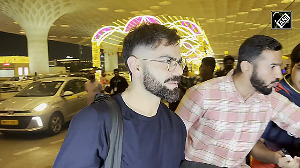 Fifty years from now, the discovery of water on the moon will be termed as a Chandrayaan-1 discovery, says Indian Space Research Organisation chief G Madhavan Nair.
Fifty years from now, the discovery of water on the moon will be termed as a Chandrayaan-1 discovery, says Indian Space Research Organisation chief G Madhavan Nair.
A jubilant Nair was addressing a press conference at the ISRO headquarters in Bengaluru on Friday after a NASA payload aboard the Chandrayaan-1 found Hydroxyl, a molecule consisting one oxygen atom and one hydrogen atom, in the lunar soil.
When asked whether ISRO could take credit for this discovery, considering a NASA payload found the traces of water, he said: "This is an example of how an international space collaboration works. Fifty years from now, people will say that this was a Chandrayaan discovery. Moreover, the findings would not have been possible if not for Chandrayaan-1."
We realised in the first week of the moon mission that there were signs of water. During that period, we got signatures while the spacecraft was descending towards the moon, he said.
"When we had aborted the Chandrayaan mission due to technical problems last month, I had maintained that the mission was 95 per cent successful. However, with this discovery, I would say with confidence that the mission is 101 per cent successful," the ISRO chief said.
"I would also like to say here that thanks to this we, as Indians, can really be very proud today."
Nair explained that there are many advantages to this discovery. The traces will help us observe the possibility of human inhabitation on the moon. Further, we could also derive fuel and also launch satellites from the moon.
Kalam asked not to shout:
Speaking in a lighter vein, Nair said they had asked former President Abdul Kalam to keep the news about the discovery under wraps.
"We were aware of this fact three weeks back, but since there was an embargo with NASA we had decided against making any announcement, until NASA does it first. Dr Kalam knew this too and told us, "I want shout on top of my voice and announce this to the world."
However, we told him not to shout it out until NASA announces it first.
Chandrayaan-2
Speaking of the next mission, the Chandrayaan-2, Nair said the response has been overwhelming.
We are looking for more international collaboration for this mission. At the moment, we have Russia and NASA on board for this mission and are expecting more in the future.
For Chandrayaan-2, we will have to re-look the objective and may have to go in for some course correction, Nair also added.
Image: These images show a very young lunar crater on the side of the moon that faces away from Earth, as viewed by NASA's Moon Mineralogy Mapper on the Indian Space Research Organization's Chandrayaan-1 spacecraft. On the left is an image showing brightness at shorter infrared wavelengths. On the right, the distribution of water-rich minerals (light blue) is shown around a small crater. Both water- and hydroxyl-rich materials were found to be associated with material ejected from the crater.
Reportage: Vicky Nanjappa
Photograph courtesy: ISRO/NASA/JPL-Caltech/USGS/Brown Univ





